An element that never has a positive oxidation state in any of its compounds is
A
Boron
B
Oxygen
C
Chlorine
D
Fluorine
Video Solution
Text Solution
The correct Answer is:D
Fluorine always shows – 1 oxidation state.
|
Topper's Solved these Questions
- STOICHIOMETRY-IIBOOK - VMC MODULES ENGLISHCHAPTER - STOICHIOMETRY-IIEXERCISE - JEE Main (Archive)
21 Videos
- STOICHIOMETRY-IIBOOK - VMC MODULES ENGLISHCHAPTER - STOICHIOMETRY-IIEXERCISE - JEE Advanced (Archive)
43 Videos
- STOICHIOMETRY-IIBOOK - VMC MODULES ENGLISHCHAPTER - STOICHIOMETRY-IIEXERCISE - LEVEL (1)
75 Videos
- STOICHIOMETRY - IBOOK - VMC MODULES ENGLISHCHAPTER - STOICHIOMETRY - IEXERCISE - JEE Advanced (Archive)
31 Videos
- STRUCTURE OF ATOMBOOK - VMC MODULES ENGLISHCHAPTER - STRUCTURE OF ATOMEXERCISE - IN-CHAPTER EXERCISE-F
7 Videos
Similar Questions
Knowledge Check
Oxygen exhibits positive oxidation state in
ACOBF2OCNODN2O
The element that exhibits negative oxidation state in IIIA group is
View SolutionThe highest possible oxidation state shown by osmium in its compound is
View SolutionWhich of the following elements shows maximum number of different oxidation states in its compounds ?
(a)Eu
(b)La
(c)Gd
(d)Am
View SolutionOxygen has −1 oxidation state in the compound.
View SolutionOxygen has −2 oxidation state in the compound
View SolutionMark the element which shows only one oxidation state in its compounds
View SolutionIn general, the Transition elements exhibit their highest oxidation states in their compounds with elements like:
View Solution
